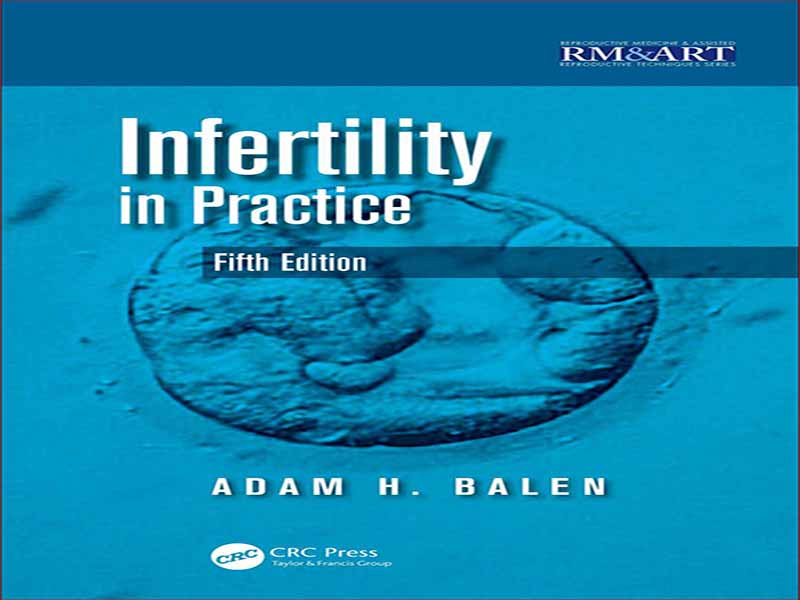- عنوان کتاب: Infertility in Practice
- نویسنده: Adam H. Balen
- حوزه: ناباروری
- سال انتشار: 2023
- تعداد صفحه: 453
- زبان اصلی: انگلیسی
- نوع فایل: pdf
- حجم فایل: 9.83 مگابایت
من خوشحالم که پنجمین ویرایش ناباروری در عمل را ارائه میدهم که از زمان انتشار آن در سال 1997 هر 5 سال یا بیشتر به روز میشود. در طول این مدت، درک ما از ناباروری و مدیریت آن به سرعت در حال گسترش است. ناباروری در عمل به عنوان یک راهنمای عملی نوشته شده است و بر اساس تجربه من در طول 40 سال گذشته از فعالیت بالینی روزانه است. هدف این کتاب قرار دادن رویکرد مدرن برای مدیریت ناباروری در چارچوب تئوری صحیح و درمان مبتنی بر شواهد است. من تلاش کرده ام تا طبقه بندی جامعی از علل ناباروری، بررسی آنها و مدیریت آنها را به خواننده ارائه دهم. در این نسخه، متن را به طور کامل اصلاح و به روز کرده ام و اکثر فصول را به طور کامل بازنویسی کرده ام. لقاح آزمایشگاهی (IVF) تقریباً 45 سال است که در دسترس بوده است، و در بسیاری از کشورهای اروپایی، 2 تا 5 درصد از نوزادان نتیجه درمان IVF هستند. در واقع، تقریباً 10 میلیون نوزاد در سراسر جهان از طریق IVF متولد شده اند که نیمی از آن در 10 سال گذشته است. توجه عموم مردم به طور طبیعی بر پیشرفتهای با تکنولوژی پیشرفته در درمانهای کمک باروری متمرکز شده است، با این حال یک موضوع اساسی سلامت قبل از بارداری هر دو طرف است که هم برای بارداری، چه طبیعی یا کمکی، و هم برای تولد کودک کلیدی است. یک نوزاد سالم من سلامت قبل از بارداری را در اولین ویرایش این کتاب در زمانی معرفی کردم که تعداد کمی از این موضوع مهم را مورد توجه قرار میدادند، و این موضوع اکنون به همان اندازه مرتبط است – اگر نه بیشتر. در این نسخه، من آخرین افکار را در مورد سلامت تغذیه، مراقبت از دوران بارداری و دنیای جدید هیجان انگیز میکروبیوم آورده ام. از زمانی که نسخه چهارم Infertility in Practice منتشر شد، پیشرفتهای زیادی در درک و مدیریت ناباروری و سایر بهروزرسانیهای عملی که در این نسخه جدید مورد بحث قرار گرفتهاند، بهعنوان مثال، درک بیشتر پاتوفیزیولوژی پیری تخمدان و تخمدانها وجود داشته است. تست ذخیره، طبقه بندی اختلالات تخمک گذاری و مدیریت سندرم تخمدان پلی کیستیک، اصلاح رژیم های فوق تخمک گذاری، بهبود سیستم های کشت جنین و استفاده از هوش مصنوعی برای انتخاب جنین، ارزیابی پذیرش آندومتر و مدیریت شکست مکرر لانه گزینی، و آزمایش ژنتیک قبل از کاشت (PGT) به عنوان یک ابزار درمانی، امکان غربالگری آنیوپلوئیدی را باز می کند. رویکرد بالینی به بررسی و درمان نیز گام های بزرگی برای به حداقل رساندن زمان صرف شده برای رسیدن به تشخیص و هدایت سریع زوجین به سمت درمان مناسب برداشته است. این زمینه همچنین شاهد انتشار تعدادی از دستورالعمل های مبتنی بر شواهد برای بررسی و مدیریت ناباروری است که توسط انجمن باروری بریتانیا، کالج سلطنتی متخصصین زنان و زایمان، مؤسسه ملی بریتانیا برای تعالی بهداشت و مراقبت تهیه شده است. انجمن اروپایی تولید مثل انسان و جنین شناسی، انجمن آمریکایی پزشکی تولیدمثل و سازمان بهداشت جهانی. مشاهده ادغام دانش در تلاش برای اطمینان از عملکرد مبتنی بر شواهد، که در بریتانیا برای ارائه بودجه کافی برای مراقبت از باروری مورد استفاده قرار گرفته است، امیدوارکننده است، اگرچه متأسفانه تأثیر کمی بر تصمیم گیرندگان در دولت دارد. . هنگامی که فرد در حال تعیین درمان مناسب برای مدیریت ناباروری است، ممکن است یک درمان واضح یا چندین گزینه بالقوه وجود داشته باشد. علاوه بر این، اغلب داروهای مختلفی برای انتخاب بین و چندین پروتکل درمانی بالقوه وجود دارد. مهم است که نه تنها اثربخشی درمان، بلکه مقرون به صرفه بودن آن نیز بر اساس ترکیبی از شواهد علمی و اقتصاد سلامت در نظر گرفته شود. روندی برای تجزیه و تحلیل های مقرون به صرفه وجود دارد که توسط صنعت داروسازی حمایت می شود. اگرچه بسیاری از تحقیقات بدون حمایت صنعت انجام نمیشود، مهم است که هنگام تفسیر چنین دادههایی محتاط باشیم. درمان های بسیاری از علل ناباروری، شانس تجمعی بسیار رضایت بخشی برای بارداری و تولد یک کودک سالم را فراهم می کند. با این حال، عوارض جانبی باید در نظر گرفته شود، چه خطر فوری سندرم تحریک بیش از حد تخمدان و حاملگی چند قلو باشد یا خطرات درازمدت سلامتی، مانند احتمال سرطان تخمدان (به طور مطمئن نه تهدیدی که زمانی تصور می شد وجود داشته باشد. ). در این نسخه، من همچنین در مورد نتیجه کودکان متولد شده در نتیجه فن آوری کمک باروری صحبت می کنم. پیشرفتها در فنآوریهای انجماد در حال حاضر امکان انجماد موفقیتآمیز تخمکها، بافت تخمدان و حتی بافت بیضه و چشمانداز حفظ باروری را قبل از درمان عقیمسازی برای سرطان و سایر شرایط فراهم میکند. بحث برانگیزتر احتمال فریز کردن تخمک ها به عنوان یک بیمه نامه برای زنان جوانی است که می خواهند به دلایل اجتماعی فرزندآوری را به تاخیر بیندازند.
I am pleased to present the fifth edition of Infertility in Practice, which has been updated every 5 years or so since it was first published in 1997. Throughout this time, our understanding of infertility and its management has continued to expand rapidly. Infertility in Practice has been written as a practical guide and is based on my experience over the last 40 years of daily clinical practice. The aim of the book is to place the modern approach to the management of infertility in the context of sound theory and evidence-based therapy. I have striven to provide the reader with a comprehensive classification of the causes of infertility, their investigation and their management. In this edition, I have thoroughly revised and updated the text and completely rewritten most of the chapters. In vitro fertilisation (IVF) has been available for almost 45 years, and, in many European countries, 2–5% of babies are the result of IVF therapy. Indeed, approximately 10 million babies have been born worldwide from IVF, half in the last 10 years. A great deal of public attention has naturally been focused on the high-tech advances in assisted conception therapies, yet a fundamental issue is the preconception health of both partners, which is key both to conception, whether natural or assisted, and to the birth of a healthy baby. I introduced preconception health in the very first edition of this book at a time when few were addressing this important topic, and it remains just as relevant now – if not more so. In this edition, I bring in the latest thoughts on nutritional health, periconception care and the exciting new world of the microbiome. Since the fourth edition of Infertility in Practice was published, there have been many advances in the understanding and management of infertility and other updates to practice that are discussed in this new edition – for example, a greater understanding of the pathophysiology of ovarian ageing and ovarian reserve testing, classification of disorders of ovulation and the management of polycystic ovary syndrome, refinement of regimens for superovulation, improved embryo culture systems and the use of artificial intelligence for the selection of embryos, assessments for endometrial receptivity and management of recurrent implantation failure, and pre-implantation genetic testing (PGT) as a therapeutic tool, opening up the possibility for aneuploidy screening. The clinical approach to investigation and therapy also has made great strides to minimise the time taken to reach a diagnosis and direct a couple swiftly to the appropriate treatment. The field has also seen the publication of a number of evidence-based guidelines for the investigation and management of infertility, produced variously by the British Fertility Society, the Royal College of Obstetricians and Gynaecologists, the UK National Institute for Health and Care Excellence, the European Society for Human Reproduction and Embryology, the American Society for Reproductive Medicine and The World Health Organisation. It is reassuring to see a consolidation of knowledge in an attempt to ensure evidence-based practice which, in the United Kingdom, has been used to state the case for adequate funding of fertility care, although sadly with little effect on the decision makers in government. When one is determining appropriate treatment for the management of infertility, there may be one clear treatment or several potential options. Furthermore, there are often a variety of drugs to choose between and several potential treatment protocols. It is important to consider not only the efficacy of treatment but also its cost-effectiveness on the basis of a combination of scientific evidence and health economics. There has been a trend for cost-effectiveness analyses to be sponsored by the pharmaceutical industry. Although much research could not take place without industry support, it is important to be cautious when interpreting such data. The treatments for most causes of infertility provide very satisfactory cumulative chances of conception and of the birth of a healthy child. However, the side effects must be borne in mind, whether it is the immediate risk of ovarian hyperstimulation syndrome and multiple pregnancy or the long-term health risks, such as the possibility of ovarian cancer (reassuringly not the threat it was once thought to be). In this edition, I also discuss the outcome for children born as a result of assisted reproduction technology. Improvements in cryopreservation technologies now enable the successful freezing of oocytes, ovarian tissue and even testicular tissue and the prospect of preserving fertility before sterilisation therapy for cancer and other conditions. More controversial is the potential to freeze oocytes as an insurance policy for young women who wish to delay childbearing for social reasons.
این کتاب را میتوانید از لینک زیر بصورت رایگان دانلود کنید:
Download: Infertility in Practice




































نظرات کاربران